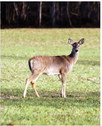Baiting ban set


As expected, the Wisconsin Department of Natural Resources (DNR) has established a ban on baiting and feeding white-tailed deer in response to notification on Aug. 11 from the Wisconsi...


As expected, the Wisconsin Department of Natural Resources (DNR) has established a ban on baiting and feeding white-tailed deer in response to notification on Aug. 11 from the Wisconsi...